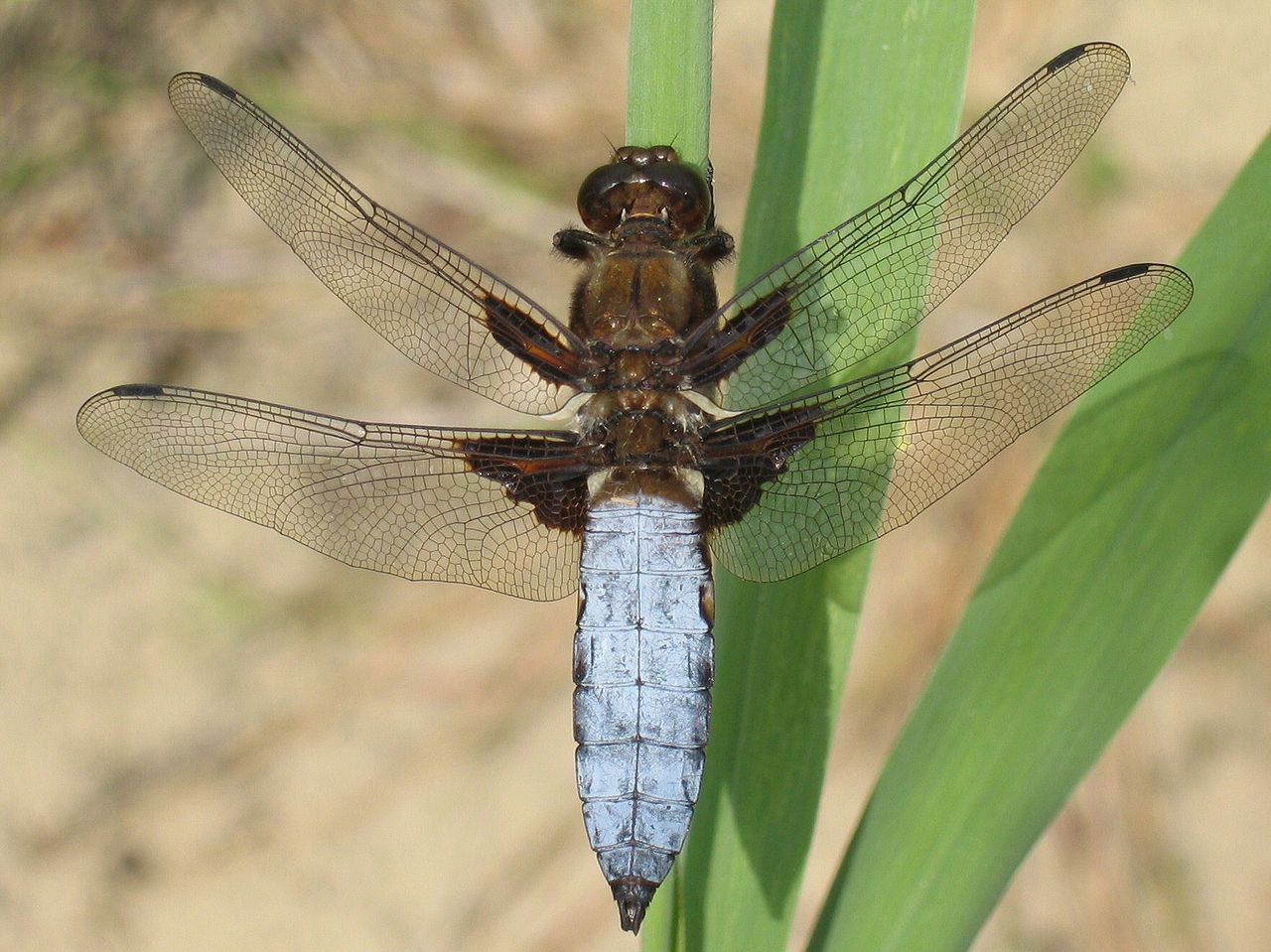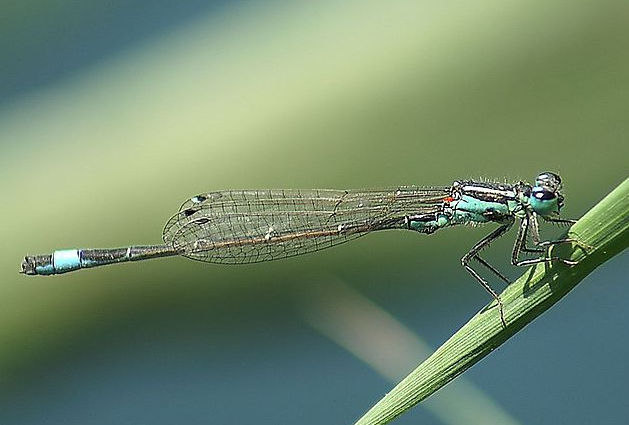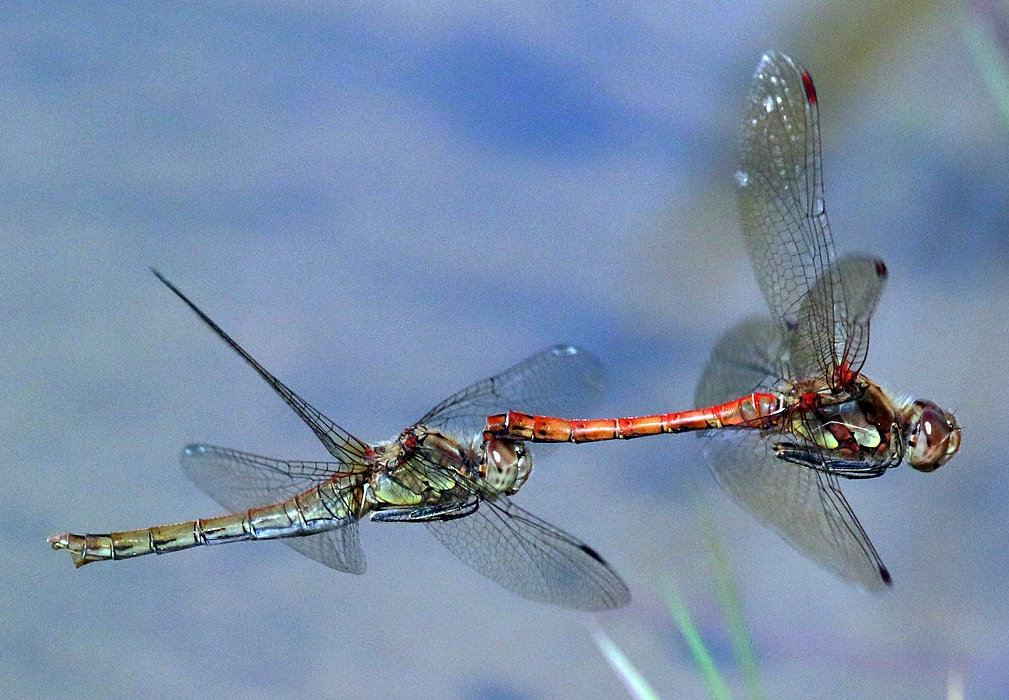



- Home
- Garden Wildlife
- Insects
- Dragons/damsels
Dragonflies and damselflies - introduction
Dragonflies and damselflies are insects belonging to the order Odonata. This is one of the oldest insect orders, going back to the Permian period about 290 million years ago. The early fossil Meganeuropsis permiana was
the largest insect ever, with a wingspan up to 71cm and body length of 43cm. Even today, the largest tropical dragonfly reaches about 16.5cm wingspan. They are predators throughout their life cycle, and the adults have long grasping legs for seizing prey in the air.
The Odonata are divided into two sub-orders, the Dragonflies in the sub-order Anisoptera and damselflies in the sub-order Zygoptera. The two suborders are quite easily distinguished. Our two further pages on the dragonflies and damselflies show examples of species common in gardens.
Dragonflies are generally bigger, with thicker abdomens, and much stronger fliers than damselflies and also have dissimilar shaped hind and forewings. Their hind wings are shorter and broader than the forewings, whereas damselflies have hind and forewings of equal shape and size. When at rest, dragonflies hold their wings out horizontally from their bodies like aeroplanes. Damselflies hold their wings folded back above their bodies. The enormous compound eyes on a dragonfly’s head touch each other above the head, whereas the eyes on a damselfly are clearly separated to the sides of the head.
Common darter Sympetrum striolatum pair in tandem flight Azure damsels Coenagrion puella in mating "wheel".
Some dragonflies and damselflies deposit their eggs by dipping the tip of the abdomen underwater and placing the eggs on water plants. Others flick their eggs into the water while in flight. The eggs usually hatch within a few weeks and the nymphal stage will overwinter. Others lay the eggs on waterside vegetation or structures. Some, however, like the southern hawker and common darter overwinter in the egg stage. The nymphal stages last up to two years depending on the species.
When the nymphal stages have been completed, the fully developed nymphs emerge from the water and climb up the stems of nearby plants. The nymphal skin splits down the back, allowing the adult to emerge and expand its wings. Empty nymphal skins are known as exuviae. Newly emerged adults often have drab colours and it may take several days before the bright colours typical of many dragonflies and damselflies develop. Newly emerged adults will feed for about a week or so before mating. During that time, dragonflies in particular will often roam away from likely breeding places.
Role of dragonflies and damselflies in gardens
Damselflies and dragonflies prey on insects and other small animals during both their nymphal and adult stages. Due to their size and colour, the adult insects are very enjoyable to watch as they patrol a pond in search of prey or a mate.
Encouraging dragonflies and damselflies in the garden
The best action you can take is to create one or more ponds in your garden. Odonata are not very exacting in their requirements, but larger ponds are likely to be more effective. It's important to have surface and emergent vegetation for egg-laying, and for mature larvae to climb out and emerge as adults. While some species of dragonflies live most of their adult life on the wing, many others need taller vegetation on which they can perch while waiting for food or mates.
Even gardens without ponds will be visited by dragonflies in particular, searching for flying insect food. They feed on small flies, mosquitoes and midges, butterflies and moths and other Odonata. This means that a garden which supports and attracts good numbers of flying insects will be a good resource for these attractive insects
Other sources of information
Websites
Website of the British Dragonfly Society
Steve Falk's pages and information on odonata.
Facebook group UK Dragonflies and damselflies
Facebook Group British Butterflies Moths and Dragonflies
Natural England leaflet on dragonflies and damselflies
Books
Smallshire, D and Swash, A (2018) Britain's Dragonflies: A Field Guide to the Damselflies and Dragonflies of Great Britain and Ireland. Wild Guides
Brooks, S., Cham, S. and Lewington, R. (2018) Field Guide to the dragonflies and damselflies of Great Britain and Ireland. Bloomsbury Wildlife Guides
Cham, S. (2012) Field Guide to the larvae and exuviae of British Dragonflies - Dragonflies (Anisoptera) and Damselflies (Zygoptera). British Dragonfly Society
Corbet, P. & Brooks, S. (2008) Dragonflies Collins New Naturalist series no 106. Harper Collins
Dobson,M. Pawley,S. Fletcher,M. & Powell, A. (2012) Guide to Freshwater Invertebrates Published by Freshwater Biological Association
Page text drafted by Andrew Halstead, reviewed by Andrew Salisbury, compiled by Steve Head
![Head of Platycnemis pennipes Photo: Gilles San Martin from Namur, Belgium [CC BY-SA 2.0 (https://creativecommons.org/licenses/by-sa/2.0)]](images/Face_of_the_White-legged_Damselfly_-_Platycnemis_pennipes.jpg)
.jpg)
Above left: Broad-bodied chaser dragonfly Libellula depressa with inset image of dragonfly eyes. Above right: Blue-tailed damselfly Ischnura elegans with similar inset.
Odonata have aquatic pre-adult stages, so are associated with ponds and rivers, but the adults hunt well away from their larval homes. They are exopterygotes with wing-buds developing through the larval instars and no pupal stage, so the larvae should be referred to as nymphs. However, there are profound differences between the last nymphal stage and the adult, not least in mouthparts, breathing mechanisms and locomotion. The nymphs are illustrated in the pages specific to each group.
Biology
As adults, dragonflies and damselflies prey on a variety of flies and other insects that they capture in flight. Their legs are used to seize the prey insect, with the meal being consumed when the captor alights on a nearby perch. The males of some dragonfly species are very territorial and will chase off other male dragonflies that enter their patch. The nymphs of dragonflies and damselflies are also predatory and they feed on small fish, tadpoles, aquatic insects and other small pond creatures.
Life cycle
Dragonflies and damselflies have a mating system not found in other insects. The male’s reproductive organs are situated inside the rear end of the abdomen, as in other insects. To mate the male bends the tip of his abdomen round and places the semen in a pouch on the underside of his second abdominal segment. During mating, the male uses the tip of his abdomen to grasp the female just behind her head. She will then bend the tip of her abdomen up to the underside of the base of the male’s abdomen to receive the semen, in what is termed the "wheel formation". Males and females will often fly attached together during the mating and egg-laying period.

.jpg)
Dragonflies and damselflies - introduction
Dragonflies and damselflies are insects belonging to the order Odonata. This is one of the oldest insect orders, going back to the Permian period about 290 million years ago. The early fossil Meganeuropsis permiana was
the largest insect ever, with a wingspan up to 71cm and body length of 43cm. Even today, the largest tropical dragonfly reaches about 16.5cm wingspan. They are predators throughout their life cycle, and the adults have long grasping legs for seizing prey in the air.
The Odonata are divided into two sub-orders, the Dragonflies in the sub-order Anisoptera and damselflies in the sub-order Zygoptera. The two suborders are quite easily distinguished.
Dragonflies are generally bigger, with thicker abdomens, and much stronger fliers than damselflies and also have unequal shaped hind and forewings. Their hind wings are shorter and broader than the forewings, whereas damselflies have hind and forewings of equal shape and size. When at rest, dragonflies hold their wings out horizontally from their bodies like aeroplanes. Damselflies hold their wings folded back above their bodies. The enormous compound eyes on a dragonfly’s head touch each other above the head, whereas the eyes on a damselfly’s head are clearly separated to the sides of the head.
Dragonflies and damselflies - introduction
Dragonflies and damselflies are insects belonging to the order Odonata. This is one of the oldest insect orders, going back to the Permian period about 290 million years ago. The early fossil Meganeuropsis permiana was
the largest insect ever, with a wingspan up to 71cm and body length of 43cm. Even today, the largest tropical dragonfly reaches about 16.5cm wingspan. They are predators throughout their life cycle, and the adults have long grasping legs for seizing prey in the air.
The Odonata are divided into two sub-orders, the Dragonflies in the sub-order Anisoptera and damselflies in the sub-order Zygoptera. The two suborders are quite easily distinguished. Our two further pages on the dragonflies and damselflies show examples of species common in gardens.
Dragonflies are generally bigger, with thicker abdomens, and much stronger fliers than damselflies and also have dissimilar haped hind and forewings. Their hind wings are shorter and broader than the forewings, whereas damselflies have hind and forewings of equal shape and size. When at rest, dragonflies hold their wings out horizontally from their bodies like aeroplanes. Damselflies hold their wings folded back above their bodies. The enormous compound eyes on a dragonfly’s head touch each other above the head, whereas the eyes on a damselfly are clearly separated to the sides of the head.
![Head of Platycnemis pennipes Photo: Gilles San Martin from Namur, Belgium [CC BY-SA 2.0 (https://creativecommons.org/licenses/by-sa/2.0)]](images/Face_of_the_White-legged_Damselfly_-_Platycnemis_pennipes.jpg)
.jpg)

.jpg)
Above left: Broad-bodied chaser dragonfly Libellula depressa with inset image of dragonfly eyes. Above right: Blue-tailed damselfly Ischnura elegans with similar inset.
Odonata have aquatic pre-adult stages, so are associated with ponds and rivers, but the adults hunt well away from their larval homes. They are exopterygotes with wing-buds developing through the larval instars and no pupal stage, so the larvae should be referred to as nymphs. However, there are profound differences between the last nymphal stage and the adult, not least in mouthparts, breathing mechanisms and locomotion. The nymphs are illustrated in the pages specific to each group.
Biology
As adults, dragonflies and damselflies prey on a variety of flies and other insects that they capture in flight. Their legs are used to seize the prey insect, with the meal being consumed when the captor alights on a nearby perch. The males of some dragonfly species are very territorial and will chase off other male dragonflies that enter their patch. The nymphs of dragonflies and damselflies are also predatory and they feed on small fish, tadpoles, aquatic insects and other small pond creatures.
Life cycle
Dragonflies and damselflies have a mating system not found in other insects. The male’s reproductive organs are situated inside the rear end of the abdomen, as in other insects. To mate the male bends the tip of his abdomen round and places the semen in a pouch on the underside of his second abdominal segment. During mating, the male uses the tip of his abdomen to grasp the female just behind her head. She will then bend the tip of her abdomen up to the underside of the base of the male’s abdomen to receive the semen, in what is termed the "wheel formation". Males and females will often fly attached together during the mating and egg-laying period.
Left: Common darter Sympetrum striolatum pair in tandem flight. Right: Azure damsels Coenagrion puella in mating "wheel".
Some dragonflies and damselflies deposit their eggs by dipping the tip of the abdomen underwater and placing the eggs on water plants. Others flick their eggs into the water while in flight. The eggs usually hatch within a few weeks and the nymphal stage will overwinter. Others lay the eggs on waterside vegetation or structures. Some, however, like the southern hawker and common darter overwinter in the egg stage. The nymphal stages last up to two years depending on the species.
When the nymphal stages have been completed, the fully developed nymphs emerge from the water and climb up the stems of nearby plants. The nymphal skin splits down the back, allowing the adult to emerge and expand its wings. Empty nymphal skins are known as exuviae. Newly emerged adults often have drab colours and it may take several days before the bright colours typical of many dragonflies and damselflies develop. Newly emerged adults will feed for about a week or so before mating. During that time, dragonflies in particular will often roam away from likely breeding places.
Role of dragonflies and damselflies in gardens
Damselflies and dragonflies prey on insects and other small animals during both their nymphal and adult stages. Due to their size and colour, the adult insects are very enjoyable to watch as they patrol a pond in search of prey or a mate.
Encouraging dragonflies and damselflies in the garden
The best action you can take is to create one or more ponds in your garden. Odonata are not very exacting in their requirements, but larger ponds are likely to be more effective. It's important to have surface and emergent vegetation for egg-laying, and for mature larvae to climb out and emerge as adults. While some species of dragonflies live most of their adult life on the wing, many others need taller vegetation on which they can perch while waiting for food or mates.
Even gardens without ponds will be visited by dragonflies in particular, searching for flying insect food. They feed on small flies, mosquitoes and midges, butterflies and moths and other Odonata. This means that a garden which supports and attracts good numbers of flying insects will be a good resource for these attractive insects
Other sources of information
Websites
Website of the British Dragonfly Society
Facebook group UK Dragonflies and damselflies
Facebook Group British Butterflies Moths and Dragonflies
Books
Smallshire, D and Swash, A (2018) Britain's Dragonflies: A Field Guide to the Damselflies and Dragonflies of Great Britain and Ireland. Wild Guides
Brooks, S., Cham, S. and Lewington, R. (2018) Field Guide to the dragonflies and damselflies of Great Britain and Ireland. Bloomsbury Wildlife Guides
Cham, S. (2012) Field Guide to the larvae and exuviae of British Dragonflies - Dragonflies (Anisoptera) and Damselflies (Zygoptera). British Dragonfly Society
Corbet, P. & Brooks, S. (2008) Dragonflies Collins New Naturalist series no 106. Harper Collins
Dobson,M. Pawley,S. Fletcher,M. & Powell, A. (2012) Guide to Freshwater Invertebrates Published by Freshwater Biological Association
Page text drafted by Andrew Halstead, reviewed by Andrew Salisbury, compiled by Steve Head












